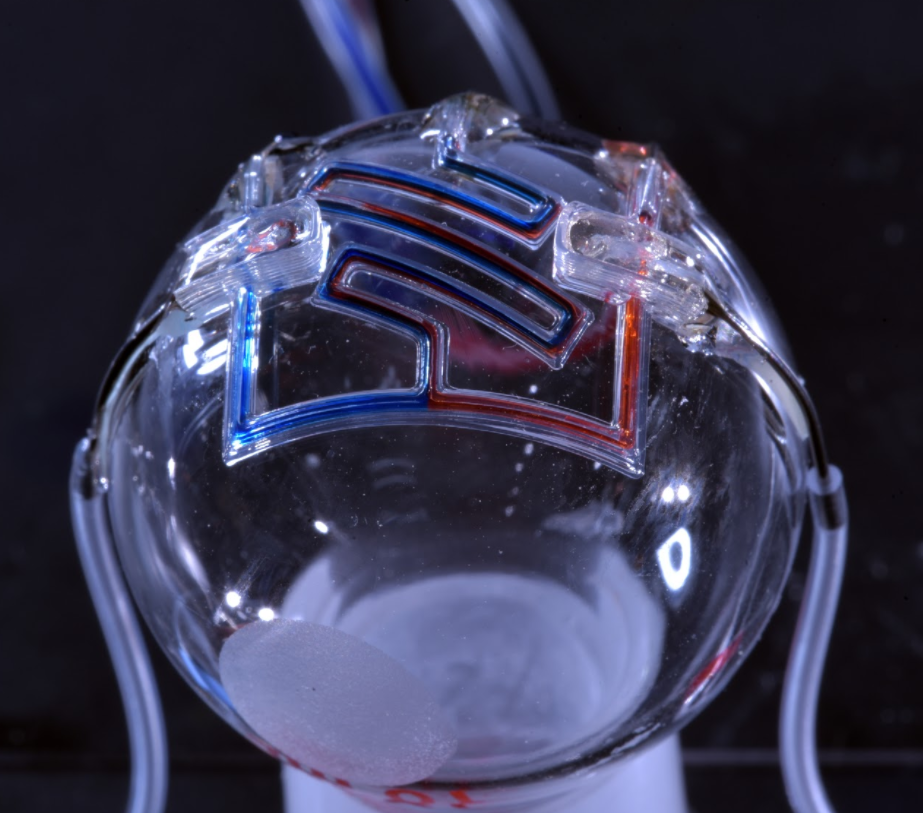3D printed microfluidic devices
An extrusion-based 3D-printing method to create enclosed microfluidic channels on freeform surfaces.

Applications
- Extrusion 3D printing
- Microfluidics - lab on a chip, sensors, bioassays, devices etc.
Key Benefits & Differentiators
- Structure is self-supporting with no sacrificial material
- Flexible and customizable for different applications
- Directly incorporate electrodes or bio-chemical sensing elements within or beneath the microfluidic structures
- Fabricate hollow microfluidic structures on any freeform surface; transcend the planar limitations of conventional microfluidic chips and platforms
Overview
Conventional technologies used to fabricate microfluidic channels suffer from being labor and material intensive, requiring numerous steps and a cleanroom environment. Additionally, these fabrication techniques require the use of high temperatures, UV light, and acid etching, all of which create constraints on final devices that can be made. For instance, manufacturing a protein-based microfluidic sensing device will require additional processes to protect the protein molecules from being damaged during the hazardous processing steps. A new 3D printing invention can overcome many of these problems in conventional manufacturing processes for microfluidics, enabling fabrication of micron-scale channels without stereolithography methods. This approach can also direct align and integrate microfluidic channels with pre-fabricated electronics.
Researchers at the University of Minnesota have developed an extrusion-based 3D-printing method to create self-supporting microchannels on freeform surfaces. By fine-tuning the material (such as silicone) and print parameters to create self-supporting, enclosed channels, this technology enables the generation of hollow 3D structures with no pre-fabricated molds or sacrificial supporting materials. Additionally, this room temperature printing method requires no post printing curing steps and the microchannels can be printed directly on to the desired device, allowing for facile alignment and integration. Lastly, this technology offers the ability to print on freeform surfaces, thereby enabling direct 3D printing of microfluidics onto any target surface, including clothing, and non-planar surfaces such as unusual circuit form factors, curved automobile or airplane component surfaces, and human skin/organs. The combination of these advantages opens opportunities for creating microfluidics-based devices such as microfluidic cooling systems in power electronics, bioreactors, and sweat detection systems, etc.
Phase of Development
TRL: 5Working prototypes and models of printed microchannels on planar and nonplanar substrates have been implemented. The researchers have demonstrated the ability to create microchannels with inner diameters sub-100 micron. The researchers have applied this 3D printing technology to create: 1) microfluidic-integrated salinity sensors via direct integration with prefabricated sensing microelectrodes, 2) microfluidic valves, pumps, and mixers, and 3) a spherical microfluidic network.
Desired Partnerships
This technology is now available for:- License
- Sponsored research
- Co-development
Please contact our office to share your business’ needs and learn more.
Researchers
- Michael McAlpine, PhD, Professor, Mechanical Engineering
- Steven Koester, PhD, Professor, Electrical and Computer Engineering
-
expand_more library_books References (1)
- Su, Ruitao, Jiaxuan Wen, Qun Su, Michael S. Wiederoder, Steven J. Koester, Joshua R. Uzarski, and Michael C. McAlpine , "3D printed self-supporting elastomeric structures for multifunctional microfluidics.", Science advances 6, no. 41 (2020): eabc9846.
-
expand_more cloud_download Supporting documents (1)Product brochure3D printed microfluidic devices.pdf